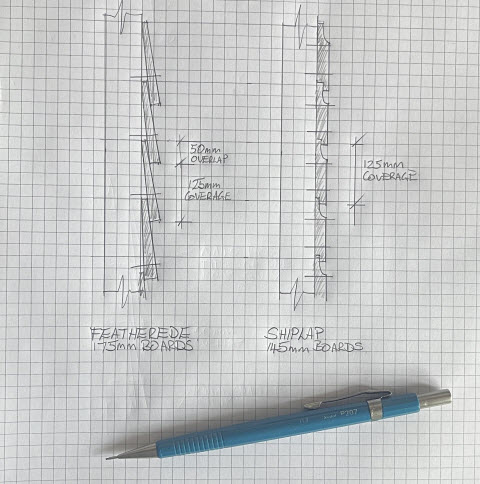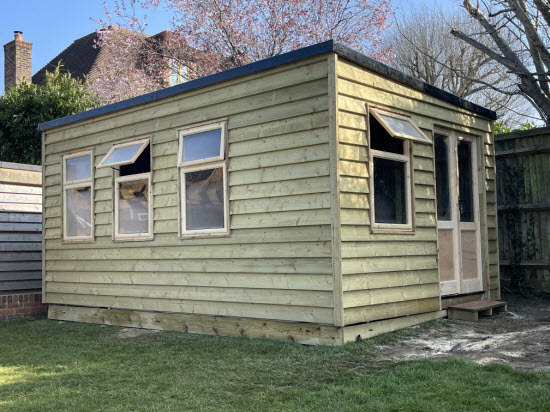Featheredge vs Shiplap - And the Cladding Decision That Surprises People
I've built sheds with both. Featheredge, rough-sawn and overlapping like roof tiles. Shiplap, smooth-planed with a rebated joint that locks tight and looks sharp. And I'll be honest - most people only really think about cladding when they're nearly finished planning everything else.
That's when the questions start.
- 'What's the difference, anyway?'
- 'Which one lasts longer?'
- 'Which one's easier to put up?'
- 'Which one looks better next to the patio?'
The short answer? It depends.
Featheredge and shiplap are both excellent choices - but they solve slightly different problems. In this guide, I'll walk you through the differences that matter: how they look, how they handle the weather, what they cost, and what to expect when installing each one.
 Featheredge vs. Shiplap - These are the two shed cladding profiles that we are comparing
Featheredge vs. Shiplap - These are the two shed cladding profiles that we are comparing
What Exactly Are Featheredge and Shiplap Cladding?
You could be forgiven for thinking all timber cladding is the same - boards nailed to a wall, job done. But the way those boards are shaped makes a huge difference to how the shed looks, how it sheds water, and how you fit them.
Featheredge is the classic option. Rough-sawn boards, each one tapered - thick at one edge, thin at the other. You overlap them from bottom to top, like roof tiles.
Shiplap, on the other hand, is more refined. It's made from planed boards with a rebate - a kind of step - that lets each piece slot over the next, giving a flush face with a deep groove.
 How Featheredge and Shiplap Cladding Work
How Featheredge and Shiplap Cladding Work
What Kind of Look Do You Want? (And What Will It Say About Your Shed?)
Featheredge has that rough, honest charm. Great for working sheds or rustic outbuildings. It weathers to a silver tone if left untreated.
 Shed with Featheredge Cladding - the slightly rustic look
Shed with Featheredge Cladding - the slightly rustic look
Shiplap feels neater. Cleaner lines, smoother surface, and ideal for sheds that are part of a landscaped garden.
 Shed with Shiplap Cladding - a slightly smoother look
Shed with Shiplap Cladding - a slightly smoother look
Which One Handles the Weather Better? (It's Closer Than You Think)
Shiplap's rebated joint creates a tight seal. But feather edge's overlapping design works just as well - provided the detailing is sound. Overhangs, treatment, and proper fixings matter more than the cladding style itself.
Featheredge vs Shiplap: Which Is Easier to Install on a Shed?(It's Not the One Most People Think)
Featheredge seems simpler but requires more judgement. Overlap must be consistent, and the varying thickness adds complexity. Shiplap's rebates guide alignment, making it easier for solo builders and neater overall.
Featheredge vs Shiplap: Which Costs More
Featheredge is the cheaper option — both per linear metre and per square metre — often by 20 to 30%. That’s largely because it involves less processing and handling, and you’re not losing material to planing or profiling. You get more timber for your money.
Shiplap, is more expensive and takes about the same time to install as featheredge. It is slightly easier to line up - and its smooth surface takes paint or stain more evenly, which some people prefer for a neater finish.
Which One Lasts Longer? (It Comes Down to the Details)
Shiplap looks more refined and often uses higher-grade timber. But featheredge absorbs treatment well and protects the thin edge under overlaps. With proper detailing, both last well.
When to Choose Featheredge, and When Shiplap Makes More Sense
| Use Case | Best Option |
|---|---|
| Tool shed or utility outbuilding | Featheredge - cost-effective and tough |
| Garden office or summerhouse | Shiplap - clean lines and refined look |
| Painting or staining | Shiplap - smoother surface for finish |
| Low-maintenance, treated timber build | Featheredge - weathers well if detailed right |
| Solo building or quick install | Shiplap - easy alignment |
| Rural or rustic setting | Featheredge - weathers naturally |
Conclusion: You're Not Just Picking a Cladding - You're Picking a Personality
Featheredge or shiplap? It's not about right or wrong - it's about what fits your shed, your setting, and your expectations.
Featheredge brings strength and tradition. Shiplap offers polish and precision. Both can last. Both can look fantastic. And now, you know how to choose.

Keep in touch with our monthly newsletter
Shed Building Monthly




